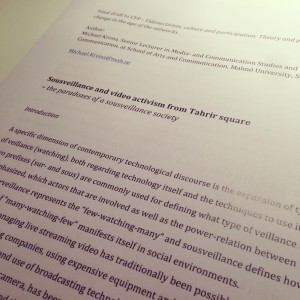Yesterday I submitted a final draft for a chapter in a forthcoming anthology on Video activism in the age of networks. My text evolves around the use of mobile technologies and applications to stream moving images live with a potential global reach, situated in a pretext of protests and political turmoil. The case in this text regards Egypt and the demonstrations during early 2011 at Tahrir in Cairo, one of the most recognized and symbolic events of the so called Arab spring.
The aim of the article is to enhance current discussions on how resistance technologies, as it’s often labelled in both media- and academic debates, can refer to more than just appraisals of social media as tools for liberation or as ‘freedom technologies’, but also serve as a conceptualization of more long-term structural and social threats to society, especially an incrimination of public spheres (offline and online).
My approach is mainly theoretical, drawing on present research on media- and video activism and sousveillance society. The latter constitutes my main entry-point when trying to comprehend not only the democratic aspects of video activism, but also the consequences regarding increased surveillance practices performed by oppressive regimes in the Arab world.
For instance, I discuss the activists’ use of online video-streaming as part of a “surveillance arms race”, a battle in which activits increased use of cameras in cellphones monitoring its oppressors/surveillers, triggered the regime itself to use more drastic measures to take control of technology and information. This in turn led to activists and protesters to develop new strategies for distributing images mainly to an international audience and reach out to the international community, which naturally again led to even further interventions by the regime and police. Hence, one of my arguments is that the use of sousvillance technologies (with democratic intentions), may lead to increased surveillance by the opponent side, talking drastic measures of obtaining control, often hurting more people than those taking part in the actual protest.
Now, this may sound pessimistic or bleak. However that is not my intention with the text. My intention is to extract some key features of the “discoursive constructions of liberation technologies”, the way we think and talk about technology in a specific context, and discuss dimensions moving outside the often very optimistic nature of technological discourse (especially during the Arab spring where democratic reforms were sought). This does not mean that I oppose or don’t acknowledge the major significance that social networks in general, and online video streaming services in particular, have had during the uprisings. I have written about that as well. But in this particular text my focus is more directed on the tactics and counter-reactions from the surveillers as well, in this case states, regimes and police authorities. Using video activism as a central part of mobilising and coordinating efforts have proven to be extremely important for social movements and other organisations seeking social and political change. However it is my firm belief that if the technology are to be used as effective as possible and contribute to a more long-term change, especially in the MENA region which is of interest to me, we need to widen the concept of resistance technologies and also observe the social implications when the surveillance society and institutions react to a development.

